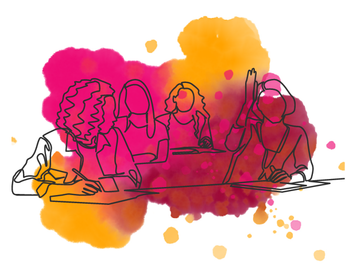Four key considerations for a blended rotational model
Make sure the students are able to use the equipment and the software required for rotations, and have the necessary resources to succeed in the course.
-
For example, if course activities include the use of an LMS, provide instructions on how to navigate the course shell at the beginning of a course.
Rotation through class-wide, small group and individual learning activities and balancing different types of activities across the stations can promote a more communicative and collaborative environment for courses that typically have limited opportunities for peer-to-peer interaction.
-
For example, students can rotate through the modules as part of a small group, get randomly assigned into groups in a certain module, or participate in the rotations individually thoughout the course.
In addition to low-stakes formative assessments between rotations, the course can include a summative assessment. The rotational model is well-suited for project-based work, which results in the creation of a final lab report, reflective essay or an artpiece.
-
For example, academic integrity through assessment is promoted by tracking the students’ progress in the course as they move through the modules and/or rotations.
Scheduling rotations through physical and online spaces in the course increases accessibility for the learners, who might have limited access to the campus spaces required for labs.
-
For example, more students can access sophisticated pieces of equipment if they take turns, rotating through the section based on the schedule.
Learning activities
Learning activities in a blended rotational design can provide learners with an opportunity to work on a complex task (e.g., solving a problem) and complete it gradually, building upon the knowledge and skills acquired in the previous modules. Align the learning space to best meet the learning objective while optimizing student interactions.
Recommendation: Use online spaces before the face-to-face component to provide the necessary background information for the experiment.
-
Online
Students analyze, interpret the data and formulate a hypothesis.
-
Face-to-face
Students perform an experiment and record the data on campus using a given protocol.
Recommendation: Use a problem-solving framework to match the rotations to the stages of problem-solving process.
-
Online
Students get assigned a problem and receive feedback on their ideation process.
-
Face-to-face
Students test their proposed solution to the problem or the question.
Example: Use team contracts or peer evaluation to set the rules for group work.
-
Online
Groups present their reports to the peers and share their feedback.
-
Face-to-face
Students work on an experiment in a group using the equipment on campus.
Learning assessments
Assessments in a blended rotational model can take place in either learning modality.
The most common types of blended rotational model assessments include online tests and quizzes and in-class seminar self-assessments, written reports, projects, peer-reflections, and demonstrations (Yang, 2019).
Assessments are given at the end of each rotation and are tailored to the learning activities in that rotation. For example, small group lab rotations could result in a group lab report.
Online: Tests students’ technical knowledge after completing a station.
Face-to-face: Students are asked questions posed by seminar tutors and can be asked to complete a self-assessment to confirm understanding.
Face-to-face: Students present live demonstrations that indicate students have met the learning objectives.
Online: A short-written report elaborating on demonstrations or mini-project tasks provides further evidence of learning.
Face-to-face: Students are paired and given mini-project tasks to allow them to demonstrate their acquired knowledge.
Face-to-face: Provided after pairs mini-project tasks assessing critical thinking and analytical skills.
Lesson checklist
-
Discover three types of rotational models
-
Identify the core elements of the rotational model
-
Determine key considerations when using the rotational model
References
Ayob, N., Halim, N., Zulkifli, N., Zaid, N. and Mokhtar, M., 2020. Overview of Blended Learning: The Effect of Station Rotation Model on Students' Achievement. Journal of critical reviews, 7(06). http://www.jcreview.com/fulltext/197-1587744358.pdf
Cleveland-Innes, M., & Wilton, D. (2018). Guide to Blended Learning. Oasis.col.org. Retrieved 16 June 2021, from http://oasis.col.org/handle/11599/3095
Staker, H., & Horn, M. B. (2012). Classifying K-12 Blended Learning. San Mateo: Innosight Institute, Inc. https://files.eric.ed.gov/fulltext/ED535180.pdf
Yang, S. & Newman, Ro. (2019). Rotational Blended Learning in Computer System Engineering Courses. IEEE Transactions on Education, 62(4), 264–269. https://doi.org/10.1109/TE.2019.2899095




